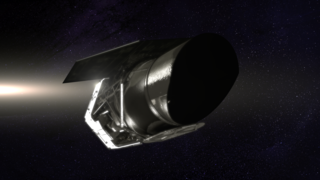Universe
ID: 12313
The first exoplanets to be discovered were gas giants, but today it is becoming clear that there are probably many more "small" planets, in the Earth to Super-Earth range, than there are giants. Discovering the statistics of these planets is crucial for understanding their formation and commonality. Gravitational microlensing is a method of finding exoplanets by watching for when their gravity slightly magnifies the light from background stars. This technique will tell us how common Earth- like planets are, and will guide the design of future exoplanet imaging missions.
More than 20 planets have been discovered from the ground using this technique. The Nancy Grace Roman Space Telescope microlensing survey will detect many more such planets, including smaller mass planets since the planet "spike" will be far more likely to be observed from a space-based platform. This will lead to a statistical census of exoplanets with masses greater than a tenth of the Earth's mass from the outer habitable zone out to free floating planets. The results from the Roman Space Telescope microlensing survey will complement the exoplanet statistics from Kepler, and will provide answers to questions about planet formation, evolution, and the prevalence of planets in the galaxy.
Roman Space Telescope Milky Way Exoplanet Locations Animation
More than 20 planets have been discovered from the ground using this technique. The Nancy Grace Roman Space Telescope microlensing survey will detect many more such planets, including smaller mass planets since the planet "spike" will be far more likely to be observed from a space-based platform. This will lead to a statistical census of exoplanets with masses greater than a tenth of the Earth's mass from the outer habitable zone out to free floating planets. The results from the Roman Space Telescope microlensing survey will complement the exoplanet statistics from Kepler, and will provide answers to questions about planet formation, evolution, and the prevalence of planets in the galaxy.
Used Elsewhere In
Related
Credits
Scott Wiessinger (USRA): Lead Producer
Aaron E. Lepsch (ADNET Systems, Inc.): Technical Support
Scott Wiessinger (USRA): Lead Animator
Aaron E. Lepsch (ADNET Systems, Inc.): Technical Support
Scott Wiessinger (USRA): Lead Animator
Please give credit for this item to:
NASA's Goddard Space Flight Center
NASA's Goddard Space Flight Center
Short URL to share this page:
https://svs.gsfc.nasa.gov/12313
Missions:
Wide-Field Infrared Survey Telescope (WFIRST)
Nancy Grace Roman Space Telescope
This item is part of these series:
Astrophysics Animations
WFIRST Pre-Launch
Keywords:
SVS >> Milky Way
SVS >> Astrophysics
NASA Science >> Universe
SVS >> Exoplanet
SVS >> WFIRST
SVS >> 4K
SVS >> Nancy Grace Roman Space Telescope
https://svs.gsfc.nasa.gov/12313
Missions:
Wide-Field Infrared Survey Telescope (WFIRST)
Nancy Grace Roman Space Telescope
This item is part of these series:
Astrophysics Animations
WFIRST Pre-Launch
Keywords:
SVS >> Milky Way
SVS >> Astrophysics
NASA Science >> Universe
SVS >> Exoplanet
SVS >> WFIRST
SVS >> 4K
SVS >> Nancy Grace Roman Space Telescope













